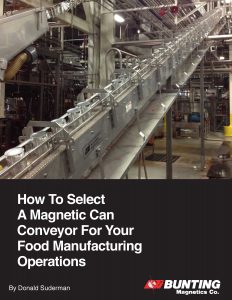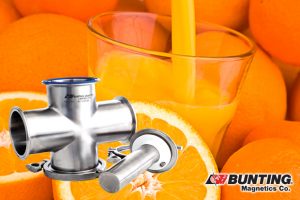
What makes food safe to eat? How are recycling companies actually able to “recycle”? How are grains kept pure? How is processing equipment protected from damaging metals? How are millions of products kept safe for consumers all over the world? It has nothing to do with Superman leaping tall buildings. The answer to these important questions is simple – it’s because of magnetic separation!
Magnetic separation has changed the world, and is responsible for product and food safety standards that we sometimes take for granted. Thanks to the innovations of magnet applications, we are able to eat food and use products that are free of dangerous materials. Magnetic separation also protects your equipment from serious damage by keeping the line clear of hazardous metal scraps. Whether you’re in the Food, Dairy, Grain and Milling, Chemical, Plastics, Oil, Textile, Recycling, Powder and Bulk, Mining, or the Non-Woven industries, magnetic separation applications are crucial to the success of your business.
Through the use of magnets, you are able to separate hazardous metals from your product before it’s shipped to consumers. This is extremely important for a number of reasons. When tramp metals are found in product and food, it can result in potential lawsuits, product recall, negative press, and severe injury to customers. Fortunately, this can all be avoided by investing in the right magnetic separation applications. The magnet separator you choose will depend on the type of material being processed and the system you are running the material through. Each system and product is unique, which means there is no “one size fits all” solution when it comes to magnetic separation.
Bunting Magnetics Co. has nearly 60 years of experience helping customers find magnetic separation solutions that fit the unique needs of their applications.
Types of Magnet Materials
The type of magnet material you choose is determined by the density of the product, its flow rates, operating temperatures, and the types of ferrous contaminants you are trying to remove. Ceramic magnets are generally used for typical tramp iron separation, while alnico magnets are better suited for high operating temperatures.
Rare earth magnets are used when product densities and flow rates are high, and encounter weakly magnetic debris and grades of work-hardened steel. Types of rare earth magnets that are used for permanent magnetic separators include: Neodymium, Samarium Cobalt, and Ceramic Ferrite. Neodymium rare earth magnets are the strongest available, and are used to remove fine iron and stainless steel. Samarium cobalt magnets are smaller, slightly weaker, and can withstand higher temperatures. Ceramic ferrite magnets are lower strength, but produce deep magnetic fields. This makes them perfect for designs where the magnetic field needs to be projected at a distance.
Types of Magnetic Applications
There is a wide selection of magnetic separators that are used in the following industries: Recycling; Aggregate, Mining and Minerals; Grain and Milling; Food Production; Plastics; Non-Woven; and Powder and Bulk. Choosing the right magnetic separator will depend on the type of material being processed and the system you are running the material through.
Drawer Magnets are ideal for gravity flow applications and are used for easy-flowing, dry material. They are typically used in the Recycling, Food, Powder and Bulk, and Plastics industries to remove fine tramp metal contaminants. Drawer magnets are available in utility, food, and sanitary construction grades with multiple cleaning options and stainless steel housings.
Drum Magnets are used for a wide range of free-flowing bulk and granular materials in high-volume applications. They provide continuous removal of ferrous contaminants, and are used in the Plastics, Recycling, Grain and Milling, Powder and Bulk, and Aggregate, Mining and Minerals industries.
Plate Magnets remove hazardous materials from powdery, moist, lumpy and abrasive products, as well as from large debris that might choke, bridge, or cause rapid wear in cartridge-based separators. Ideal for gravity free-fall applications, plate magnets can be easily installed in chutes to remove ferrous fines and large pieces of tramp iron. Plate magnets can also be installed above or below conveyor drive pulleys to capture contaminants as materials drop from open belts. They are used for handling more abrasive products, and are often used in the Plastics, Recycling, Food, Grain and Milling, and Powder and Bulk industries.
In-Line Magnets are designed for unobstructed product flow. They are usually equipped with rare earth magnets and are best used for products with slightly clumpy flow. In-line magnets are typically used in the Plastics, Recycling, Food, Grain and Milling, and Powder and Bulk industries.
Magnetic Liquid Traps remove ferrous tramp metals from liquid processing and conveying lines. They are often used in the Food, Grain and Milling, and Powder and Bulk industries, and provide protection against product contamination. Magnetic liquid traps can handle acidic food products, and remove the smallest ferrous particles from liquids with a higher viscosity.
Hump Magnets are used for high-volume product flow in the Food, Grain and Milling, Powder and Bulk, and Non-Woven industries. They increase protection against entrapped ferrous materials, while helping prevent build-up and bridging of larger products.
Grate Magnets are used in applications for the Plastics, Food, Grain and Milling, and Powder and Bulk industries. They can be installed in hoppers, pits, chutes, housings, and bins to remove tramp metals from larger flowing materials.
Wedge Magnets are installed in narrow, vertical, or steeply inclined chutes in gravity flow applications. They protect pellet mills and other equipment from damage caused by tramp metals. Wedge magnets are used in the Grain and Milling industry to process particulate or semi-solid materials.
For more information about which magnetic separators are best for your application, please contact Bunting Magnetics Co. to speak with a sales representative. We look forward to hearing from you and discussing how our magnetic separation products can help your business succeed!









